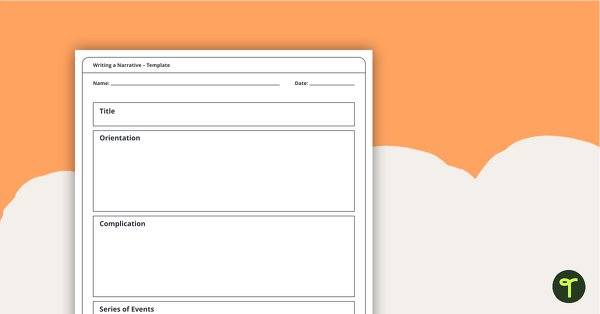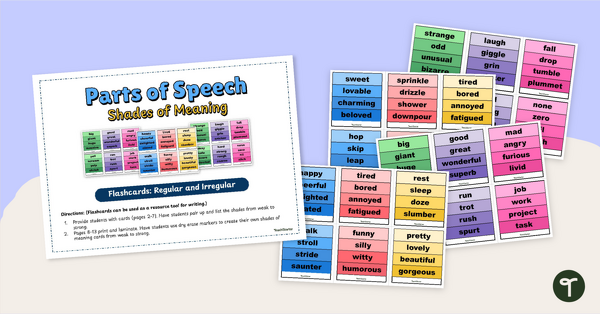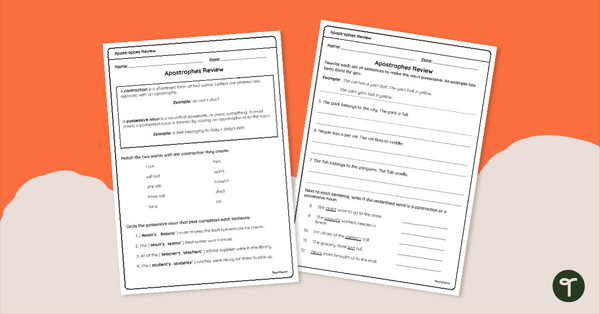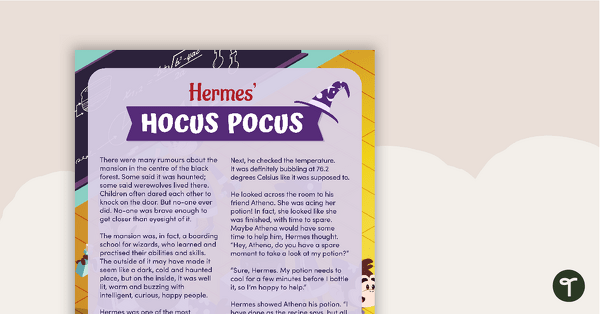Year 3
The English curriculum is built around the three interrelated strands of language, literature and literacy. Teaching and learning programs should balance and integrate all three strands. Together, the strands focus on developing students' knowledge, understanding and skills in listening, reading, viewing, speaking, writing and creating. Learning in English builds on concepts, skills and processes developed in earlier years, and teachers will revisit and strengthen these as needed.
In Years 3 and 4, students experience learning in familiar contexts and a range of contexts that relate to study in other areas of the curriculum. They interact with peers and teachers from other classes and schools in a range of face-to-face and online/virtual environments.
Students engage with a variety of texts for enjoyment. They listen to, read, view and interpret spoken, written and multimodal texts in which the primary purpose is aesthetic, as well as texts designed to inform and persuade. These encompass traditional oral texts including Aboriginal stories, picture books, various types of print and digital texts, simple chapter books, rhyming verse, poetry, non-fiction, film, multimodal texts, dramatic performances and texts used by students as models for constructing their own work.
The range of literary texts for Foundation to Year 10 comprises Australian literature, including the oral narrative traditions of Aboriginal and Torres Strait Islander Peoples, as well as the contemporary literature of these two cultural groups, and classic and contemporary world literature, including texts from and about Asia.
Literary texts that support and extend students in Years 3 and 4 as independent readers describe complex sequences of events that extend over several pages and involve unusual happenings within a framework of familiar experiences. Informative texts include content of increasing complexity and technicality about topics of interest and topics being studied in other areas of the curriculum. These texts use complex language features, including varied sentence structures, some unfamiliar vocabulary, a significant number of high-frequency sight words and words that need to be decoded phonically, and a variety of punctuation conventions, as well as illustrations and diagrams that support and extend the printed text.
Students create a range of imaginative, informative and persuasive types of texts including narratives, procedures, performances, reports, reviews, poetry and expositions.
(source: www.australiancurriculum.edu.au)
Achievement Standard
Receptive modes (listening, reading and viewing)
By the end of Year 3, students understand how content can be organised using different text structures depending on the purpose of the text. They understand how language features, images and vocabulary choices are used for different effects.
They read texts that contain varied sentence structures, a range of punctuation conventions, and images that provide extra information. They use phonics and word knowledge to fluently read more complex words. They identify literal and implied meaning connecting ideas in different parts of a text. They select information, ideas and events in texts that relate to their own lives and to other texts. They listen to others' views and respond appropriately using interaction skills.
Productive modes (speaking, writing and creating)
Students understand how language features are used to link and sequence ideas. They understand how language can be used to express feelings and opinions on topics. Their texts include writing and images to express and develop, in some detail, experiences, events, information, ideas and characters.
Students create a range of texts for familiar and unfamiliar audiences. They contribute actively to class and group discussions, asking questions, providing useful feedback and making presentations. They demonstrate understanding of grammar and choose vocabulary and punctuation appropriate to the purpose and context of their writing. They use knowledge of letter-sound relationships including consonant and vowel clusters and high-frequency words to spell words accurately. They re-read and edit their writing, checking their work for appropriate vocabulary, structure and meaning. They write using joined letters that are accurately formed and consistent in size.
(source: www.australiancurriculum.edu.au)
- Plus Plan

Writing a Narrative – Template
A template for students to use when planning a narrative text.
- Free Plan

Persuasive Planning Template
A planning template to assist students in writing a well-structured persuasive text.
- Plus Plan

Punctuation Worksheets - Lower Primary
Download our no-prep punctuation worksheets to help your students practice their skills with using a variety of punctuation marks.
- Plus Plan

Verb Group Posters
Guide your students to be better writers with this verb group poster set to display in your classroom.
- Plus Plan

Great White Shark Information Report – Writing Project
Get your students writing a great white shark information report using this age-appropriate fact file and writing scaffold.
- Plus Plan

Shades of Meaning Verb Flashcards
Encourage your students to use different shades of meaning in their sentence writing with this set of shades of meaning verb flashcards.
- Plus Plan

Types of Verbs Poster Set
Explore the different types of verbs with this set of verb posters displaying the definition and examples of action, saying, thinking and relating verbs.
- Plus Plan

Punctuation Poster Pack
Display this set of 6 punctuation posters in your classroom to remind your students of the most common punctuation marks and their uses.
- Plus Plan

Types of Verbs Teaching Slides
Teach students about the different types of verbs with this set of 38 teaching slides with activities.
- Free Plan

Apostrophe Review Worksheet
Practise using apostrophes with contractions and possessive nouns in this double-sided worksheet.
- Plus Plan

Compound Words Crossword Puzzle Pack
Boost vocabulary skills with a pack of printable Compound Word Crossword Puzzles!
- Plus Plan

Pre-Cursive Alphabet Letters Worksheets - Mixed
Use printable pre-cursive writing worksheets PDF files to learn how to write in cursive.
- Plus Plan

Modal Language Matching Activity
Have students explore high modality and low modality language with this matching game to use during your persuasive writing unit.
- Plus Plan

Rhetorical Questions Sorting Activity
Explore rhetorical question examples with your students using this set of 28 sorting cards perfect for literacy groups
- Plus Plan

List of Persuasive Devices
Download this list of persuasive devices for your students to refer to when writing a persuasive text.
- Plus Plan

Using Persuasive Devices Worksheet
Use this persuasive devices worksheet to help your students create persuasive device examples based on a specific topic.
- Free Plan

Non-Fiction Text Features Flipbook – Read and Define
Use this text features flipbook as a student-centred literacy activity to teach your students about the purpose of text features in non-fiction books.
- Plus Plan

Poetic Devices Teaching Slides
Explore examples of poetic devices using this comprehensive and age-appropriate slide deck perfect for your poetry writing unit.
- Plus Plan

Developing Persuasive Writing Skills PowerPoint (Year 3 and Year 4)
Teach your students about the structure and language features of persuasive texts with these interactive teaching slides.
- Plus Plan

Year 3 Magazine – What's Buzzing? (Issue 3)
Issue 3 of our beautifully designed, 22-page reading magazine specifically designed for Year 3 students.
- Plus Plan

Rules for Plurals - s, es, ies, ves
Display the different rules for plurals with a printable plural noun anchor chart.
- Plus Plan

Prefix Words - Classroom Display
Build a classroom word wall and boost vocabulary skills with a printable prefix classroom display.
- Free Plan

What is an Affix? Suffix Puzzle Pack
Practice building, reading, and understanding the meaning of words with suffixes with a fun set of printable puzzles for kids.
- Plus Plan

The Stern Teacher - Decodable Reader (Level 6)
Develop confident, successful readers with this phonics-based, printable decodable book.
- Plus Plan

Writing Sentences in Past, Present and Future Tense Worksheets
Practise verb tense by changing sentences into past, present and future.
- Free Plan

Vocabulary Building Template – Verbs
Expand verb vocabulary with this open-ended task.
- Plus Plan

No More 'Said' – Card Game
Develop skilled writers with expansive vocabularies by experimenting with descriptive dialogue words.
- Plus Plan

Which One? Listening Comprehension Exercise
An Interactive PowerPoint where students choose an image to match an aural description.
- Plus Plan

Preposition Monkey Business - Worksheet
A worksheet which includes an image prompt for students to make creative sentences about prepositions.
- Free Plan

Narrative Text Structure Posters
A set of 8 narrative text structure posters to add to your classroom narrative writing display.
- Free Plan

Hermes' Hocus Pocus – Comprehension Worksheet
A comprehension worksheet for a narrative from the Year 3 magazine (Issue 3).
- Plus Plan

How to Make a Paper Plane – Procedural Writing Worksheet
Explore how to make a paper plane while your students fine-tune their procedural writing skills.